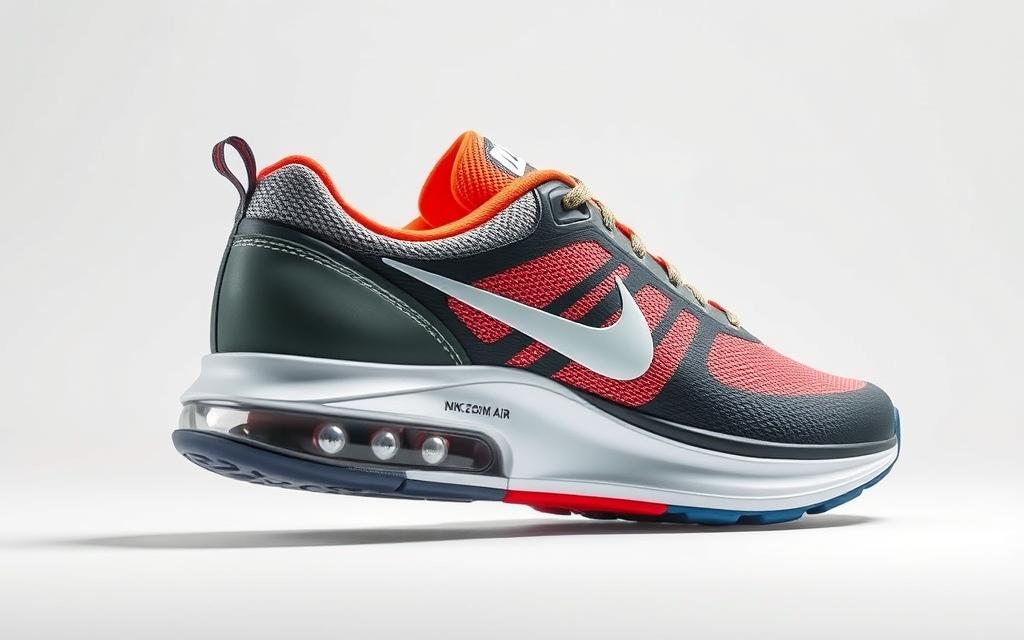what is nike zoom technology will be unpacked in this Ultimate Guide. You will learn how it works, why athletes favour it, and how to pick the right shoe for your purposes today.
The system started in 1995 and has evolved to remain a core part of Nike’s approach to innovation. Athletes praise its measurable gains in performance, especially for quick transitions and a snappy feel on track and court.
This guide shows where nike zoom sits inside the brand’s air lineup and why it is billed as the fastest cushioning option. Expect clear, data-aware sections on mechanics, key models, cross-sport uses, and evidence-based benefits.
We keep the tone practical and professional, tracking milestones from 1995 to the present year. Read on for a balanced, performance-first view that also notes the sleek look many users appreciate.
What is Nike Zoom Technology
Zoom Air defines a targeted, performance-first cushioning unit inside the broader nike air family.
At its core, Zoom Air is a low-profile, high-response cushioning system built to quicken transitions underfoot.
Definition within the Air family
The term refers specifically to a thin, pressurised air unit that houses tightly stretched fibers. It favours speed and responsiveness over plush softness.
Core components and function
Thousands of tensile fibres sit inside the pressurised chamber. When loaded, the fibres compress then rapidly rebound to help propel the foot.
- Low-profile unit keeps the foot closer to the ground for improved stability.
- The hybrid design blends gas-filled chambers with fibre tension to deliver a snappy return.
- Although many call the whole shoe “Nike Zoom,” the essential element is the Zoom Air unit placed under targeted zones.
System matters: the air, fibres and housing work together to convert impact into propulsive response, distinct from foam-only cushioning approaches.
How Zoom Air works inside the shoe
Under each step, a compact pressurised chamber and tight fibres convert force into a quick rebound.
From impact to push-off: the spring-like effect
At impact the air unit compresses and the tensile fibres tension to absorb force. Then, on push-off, those fibres snap back and create a spring-like effect.
This cycle reduces energy loss per step, so an athlete can hold pace with less perceived effort and improved performance.
Air unit construction and placement in the sole
The sealed, pressurised chamber houses tightly woven fibres that keep structural integrity under repeated loading.
Designers tune unit size and shape, matching thin, broad layouts for court feel or larger, double-stacked versions for distance protection.
Differences between forefoot and heel layouts
Forefoot placement prioritises toe-off snap and agility, giving a livelier feel beneath the foot.
Heel placement adds crash protection and smoother transitions during landing, while the low profile shortens the lever arm to improve stability.
- Multiple segmented units or pairing with different foams target distinct sensations in heel, midfoot and forefoot.
- Overall, the compact air system keeps the sole responsive without isolating ground feedback, so the shoe feels fast and controlled.
From 1995 to the present: a brief history of Zoom Air
1995 saw the debut of a compact air unit in the Air Marauder and Air Go LWP. These early models set a low-profile, fast-feel template that influenced later footwear design.
Over the following years the unit migrated across category lines. It moved from court shoes into running and training as athletes praised its quick rebound and ground feel.
Key milestones and iterative gains
Design teams refined fibre density and unit geometry over time. This improved energy return and allowed integration with new midsoles and uppers.
Consumer and athlete feedback shaped placements. Forefoot-only layouts stayed popular for agility, while full-length versions helped distance runners maintain efficiency mile after mile.
“The earliest models proved that a thin, tuned air unit could deliver a snappy, responsive ride without bulky cushioning.”
- 1995: Air Marauder and Air Go LWP debut.
- Expansion across running, basketball and training models.
- Continuous refinement of fibres, geometry and integration with new midsole foams.
Through each update the core principle remained: a pressurised, fibre-backed unit that favours responsiveness. That continuity helped the system become a staple within the broader nike air family.
Performance benefits: responsiveness, energy return and speed
A rapid rebound from compressed fibres gives many users an immediate sense of acceleration at toe-off.
Responsiveness comes from the fibres snapping back quickly. That quick rebound produces a crisp push-off and a feeling of instant acceleration.
Reducing impact on joints, muscles and tendons
The tuned chamber and fibre layout absorb and redirect force so less shock travels up the leg. This load management eases stress on joints, muscles and tendons and helps athletes keep form later into sessions.
Why runners and court athletes feel faster
By limiting energy lost at impact, more of each stride goes into forward motion. The result is practical energy return that feels like sustained speed.
The thin, stable profile improves control during quick cuts. Runners and court players report sharper first steps, more confident landings and faster transitions.
- High responsiveness yields snappy toe-off for brisk pace changes.
- Balanced cushioning prevents a sunk feeling while keeping cadence high.
- Training gains include steadier target paces and reduced fatigue for many users of appropriate nike zoom models.
Nike Zoom across sports and purposes
Engineers tune the same pressurised unit so it serves distinct athlete needs, from steady mileage to explosive cuts.
Running: distance, tempo and race-day shoes
Distance models use the unit for balanced protection and steady energy return. That layout gives comfort over many miles without losing ground feel.
Tempo shoes favour a snappier, thinner placement to speed transitions during faster workouts. Race-day options cut weight and widen the return for maximum pace.
Basketball and agility sports: quick cuts and stability
Court and team-sport shoes place the unit under the forefoot for explosive first steps. Heel units add controlled landings to boost stability during contact and rebounds.
Design trade-offs matter: thinner units preserve court feel while larger coverage suits endurance and long-distance performance.
| Sport | Unit focus | Primary benefit | Design trade-off |
|---|---|---|---|
| Distance running | Full-length / moderate size | Protection and consistent return | Less immediate snap than race models |
| Tempo / training | Forefoot-biased, thinner | Snappy transitions | Reduced cushioning for long runs |
| Basketball / agility | Forefoot + targeted heel | Explosive push-off and landing control | Tighter fit and lower stack for court feel |
- Market versatility: the same core air unit adapts across codes by pairing with different foams and traction patterns.
- Choose shoes to match movement patterns, athlete role and training focus for best on-field results.
Spotlight on popular Zoom models and categories
Different shoe lines use the same core unit in distinct ways to suit daily miles, tempo work and race day efforts.
Pegasus and daily trainers
Pegasus serves as a dependable daily trainer. Targeted units add snap to an all-round platform.
Breathable uppers and balanced stack geometry make it a versatile choice for steady mileage and mixed workouts.
Vaporfly and the racing lineage
Vaporfly traces a racing lineage that pairs superlight ZoomX foam with strategic units to boost propulsion. This combo delivers high energy return for runners chasing fast times.
Structure for stability
Structure models focus on overpronation control. An encapsulated nike zoom air forefoot unit, dual-density Cushlon, Flymesh uppers and a sculpted heel provide firm guidance and secure fit.
Vomero: cushioned responsiveness
Vomero blends ZoomX with React foam to absorb shock and convert impact into forward drive. The result is plush comfort with lively rebound on longer runs.
| Model | Category | Key underfoot tech | Primary benefit |
|---|---|---|---|
| Pegasus | Daily trainer | Targeted Zoom units, balanced stack | Reliable, snappy everyday ride |
| Vaporfly | Racing | ZoomX foam, strategic units | Maximum propulsion and energy return |
| Structure | Stability | Encapsulated forefoot unit, dual-density Cushlon | Overpronation control and guidance |
| Vomero | Tempo / long runs | ZoomX + React foam | Cushioned yet responsive ride |
Consider upper materials, unit placement and stack geometry together. Those factors shape how any pair of shoes will feel during training.
Materials and cushioning systems that amplify Zoom
Layer choices around the underfoot unit decide how the platform reacts, from first contact to toe-off.
Foam carriers and tuned ride
ZoomX foam provides a lightweight, high-return layer that stores and returns energy efficiently. In Vomero it pairs with React foam to add comfort without dulling the snap.
Dual-density Cushlon, used in Structure models, brings firmer support where needed. Together these foams tune protection and ride character around the nike zoom air unit.
Upper materials and engineered fit
Flymesh and Flywire lock the midfoot with low weight and breathability. That secure fit maintains efficient mechanics at speed and reduces internal slip.
Stability aids and outsole durability
Crash pads and heel counters guide landings and protect the heel, allowing the underfoot system to work consistently. Durable rubber compounds and tread patterns preserve grip and durability so the platform holds its feel longer.
“The cushioning system succeeds when foams, fibres and the air unit act as one rather than separate parts.”
- Holistic design: foams, fibers and air are balanced for steady responsiveness.
- Material choice: firmer carriers sharpen transitions; softer carriers feel plusher.
- Outcome: careful pairing improves longevity and maintains ride quality in every shoe.
Stability, fit and support: keeping the foot on its natural path
Stability features steer the foot along a natural path while preserving a lively ride. Designers combine guidance rails, varied-density foams and Dynamic Support to guide motion without feeling intrusive.
Medial-lateral guidance and crash rails act as subtle restraints. Crash rails and firmer foams resist excessive roll so the stride stays aligned.
Medial-lateral support and guidance rails
These elements control side-to-side motion. They engage only when the foot moves beyond its neutral line, so regular steps feel free and natural.
Encapsulated Zoom units and pressure distribution
An encapsulated air unit spreads load across a broader surface. That reduces hot spots under load and smooths transitions from heel to toe.
Rearfoot hold and structured upper matter too. A firm heel counter locks the rearfoot, while engineered mesh and Flywire secure the midfoot for consistent forefoot mechanics.
Shape and volume in the midfoot and forefoot influence comfort and control. Narrower lasts suit runners who want precision; wider shapes help those needing more room and stability.
| Feature | Primary effect | Benefit for runners |
|---|---|---|
| Crash rail / guidance rail | Limits excessive medial roll | Reduced wobble, steadier line on longer runs |
| Encapsulated air unit | Even pressure distribution | Smoother landings and reliable transitions |
| Firm heel counter | Rearfoot control | Consistent toe-off mechanics |
| Engineered mesh + Flywire | Secure, adaptive fit | Less slip and better energy transfer |
Performance translation: well-executed stability cuts wobble and improves efficiency without dulling the responsive feel athletes value. Match stability level to a gait assessment rather than choosing by cushioning alone.
Design and aesthetics: form meeting high performance
Design cues on Structure models blend function and flair, making performance visible before you step in.
Visible air, sleek lines and dynamic colourways
The visual language pairs sleek lines with technical textures to signal speed and precision.
Visible air elements and mesh panels give a purposeful, modern look while hinting at underfoot mechanics.
- Colourways and graphic treatments emphasise motion, balancing minimalism with bold contrast.
- Last shape and sculpted sidewalls suggest stability and containment while keeping the profile streamlined.
- Outsole and sole-edge detailing frame traction and cushioning tech without adding bulk.
- Reflective accents and subtle branding add visibility and a contemporary, performance-first finish.
The overall design intent is clear: the shoe should express responsiveness and confidence before the first stride. These designs make the platform readable to athletes and street users alike, blending function with a strong aesthetic.
Nike Zoom vs Nike Air Max vs Nike Shox
Not all air systems behave the same; geometry, mass and placement shape the ride.
Energy return, cushioning feel and weight differences
Zoom uses a low-profile, pressurised air unit with tensile fibres for a fast push-off. It trades bulk for quick rebound and lighter mass, so it favours performance work and speed sessions.
Air Max relies on larger visible air cushioning that offers plush comfort and bold style. These sneakers prioritise daily comfort and impact protection over razor-sharp transitions.
Shox employs columnar springs to create a pronounced bounce. That setup gives a unique ride sensation rather than the refined efficiency of a racing platform.
Best use cases: performance running vs lifestyle comfort vs bounce
- Zoom: performance running and court sports where weight, stack height and rapid transitions matter.
- Air Max: lifestyle wear, casual mileage and users who favour cushioning and visible air units.
- Shox: those seeking a distinctive, springy feel for street wear and novelty performance.
| System | Primary feel | Typical weight | Best use case |
|---|---|---|---|
| Zoom | Fast, low-profile rebound | Light | Performance running / court |
| Air Max | Plush, visible cushioning | Moderate to heavy | Lifestyle / everyday comfort |
| Shox | Bouncy, column-driven return | Moderate | Distinctive street performance |
Choosing the right Zoom shoe for your needs
Selecting the right shoe starts with a clear link between your gait, weekly load and race ambitions.
Begin by checking gait. Neutral runners often favour Pegasus or Vomero for daily miles and mixed workouts. Overpronators should try Structure for Dynamic Support, an encapsulated air unit and a firm heel that adds guidance and stability.
Tie the choice to training load and purposes. Daily mileage needs durable cushioning. Tempo sessions suit lighter, snappier setups. Race goals may justify the most propulsive lineage such as Vaporfly paired with ZoomX foam.
Fit tips for forefoot feel, heel hold and toe box shape
Assess heel hold for security at pace. A firm counter stops slip and maintains steady turnover.
Check forefoot feel for confident toe-off. The right balance between foam and unit placement affects how the foot propels forward.
Try toe box shape for long-run comfort and natural swell. A snug but not tight fit prevents hotspots and protects toes.
- Test transitions at target paces to judge turnover and responsiveness.
- Note foam blends—ZoomX, React and Cushlon change the ride from plush-crisp to sharply racier.
- Rotate a faster shoe with a daily trainer to extend kit life and keep sessions specific.
| Runner type | Recommended model | Key benefit |
|---|---|---|
| Neutral runners | Pegasus / Vomero | Balanced daily support and response |
| Overpronators | Structure | Dynamic Support and firm heel for guidance |
| Race-focused | Vaporfly / ZoomX lineage | Maximum propulsion and light weight |
Durability, maintenance and longevity of Zoom Air units
Durability depends on how the sealed chamber, fibres and surrounding foams share load across thousands of strides.
The pressurised air chamber and the tensile fibres are engineered to resist repeated loading while keeping a lively rebound. Dual-density foams, durable rubber outsoles and internal heel counters also limit deformation so the platform keeps consistent stability and responsiveness over years.
How the core holds up over time
The sealed cell tolerates compression cycles but relies on carrier foams to protect it from direct wear. Outsole rubber and crash pads take surface damage so the underfoot unit retains shape and reduces loss of energy at each step.
Care tips to preserve shape and feel
- Rotate pairs and allow shoes to dry fully between sessions to preserve foam memory and upper shape.
- Avoid prolonged heat and poor storage; high temperatures can weaken adhesives and foams and affect the air unit.
- Watch outsole wear and midsole creasing as signs that impact protection and step-to-step consistency are fading.
- Replace based on mileage and noticeable changes in ride, not calendar alone; this protects joints from reduced protection.
“Well-designed heel counters and crash pads help the platform age more gracefully by controlling deformation.”
Common myths about Zoom Air and air cushioning
Many assumptions circulate about air cushioning; few distinguish design intent from visual styling.
Not all air units feel the same. The fibre-reinforced, low-profile setup in zoom air produces a distinct push-off effect. Geometry, pressure and fibre tuning matter far more than a visible bubble or size alone.
Don’t judge responsiveness by a shoe’s look. Visible windows or bold styling often signal marketing choices rather than pure performance. True return comes from chamber pressure, fibre density and how the unit pairs with midsole foam.
Another myth says air units quickly “go flat.” In reality, pressurised systems are engineered for durability. Proper use, storage and rotation keep the sealed unit working as intended for many miles.
- Softness ≠ speed: Controlled rebound and stability usually aid performance more than excessive plushness.
- Weight savings: Replacing bulkier foam with optimised air structures can cut mass without removing protective elements.
- Lifestyle vs racing: Some expressions serve style; others are tuned for training and race outcomes—choose by function, not fashion.
“Assess the ride by testing at target paces; design details reveal the true effect underfoot.”
The market impact: how Zoom tech reshaped sneakers and performance
Arrival of a fast-feeling underfoot unit reset expectations across the running and court market.
Market perception shifted as athletes reported sharper cadence and quicker push-offs. That credibility helped solidify the brand’s standing in pure performance rather than just lifestyle footwear.
Over the following years elite race models handed down tuned features to mainstream models. The flow meant high-end gains became accessible in training options at lower price points.
The crossover into sneaker culture also mattered. Performance-first cues influenced design language, so many modern sneakers now signal speed with streamlined shapes and technical textures.
There is a clear feedback loop: success in elite kits informs mass-market versions, and consumer demand then pushes further innovation. That loop keeps the wider category fresh and competitive.
“Performance credibility carried into streetwear, making technical cues a mainstream styling shorthand.”
- Consumers can pick race-ready options for training or design-led pairs for daily wear.
- The presence of nike air lineage across lines helps the market balance heritage with cutting-edge updates.
The present and near future of Nike Zoom innovation
Today’s models pair the classic air unit with cutting-edge foams to refine how power moves through each stride.
Emerging designs and incremental updates
Designs now combine the sealed unit with ZoomX and React foam carriers to shape energy flow and transition feel.
Engineers tune unit geometry and chamber pressure in small steps. These tweaks sharpen responsiveness while keeping control and durability.
Uppers use lighter engineered mesh and refined reinforcement maps. That improves containment at speed and reduces weight for daily use.
- Foam pairings refine rebound timing and reduce unwanted instability.
- Geometry updates sharpen toe-off without adding stack height.
- Upper maps keep the foot stable through fast repetitions.
Racing prototypes feed lessons into training lines each year. Race-day gains often filter down as subtle, meaningful updates for everyday athletes.
“Expect future updates to balance propulsion gains with durability and stable support for regular training.”
| Focus area | Incremental change | Expected benefit |
|---|---|---|
| Foam pairing | ZoomX + React hybrids | Smoother energy return and tuned cushioning |
| Unit geometry | Pressure and fibre layout tweaks | Sharper transitions without loss of control |
| Upper materials | Lighter mesh, targeted reinforcements | Better containment, less mass |
| Product cycle | Race → training transfer each year | Mainstream performance gains arrive faster |
Track yearly updates for small but important gains in fit and ride. These refinements add up and influence real-world performance for many runners and players.
Conclusion
Zoom Air has become a compact, performance-led underfoot layer that converts impact into a sharp forward return and a lively feel at toe-off.
In practice, the system pairs low-profile cushioning with targeted foams to keep ride weight low and transitions crisp for race and training use.
Choose a shoe by matching gait, weekly load and event goals. Neutral runners often pick daily trainers; overpronators need models that add guidance and stability.
For court players, the same concept gives quick first steps and secure landings. For road work, it delivers efficient energy return and repeatable transitions session after session.
Over time, nike zoom has evolved, blending modern foams and structured support to keep pushing what a performance shoe can deliver.




















